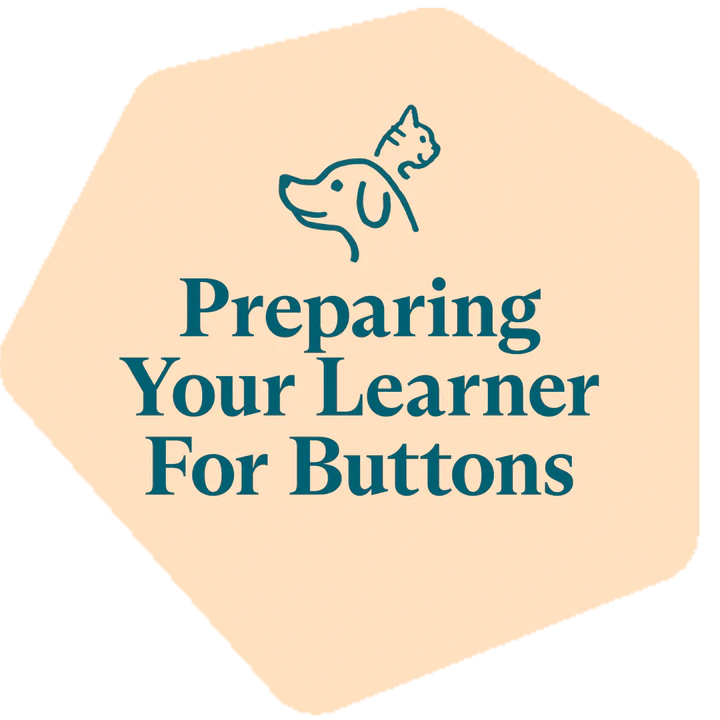Does saying “treat” make your dog tilt their head? Do they beeline for the door when you mention their long-awaited “walk”? Maybe your cat reluctantly turns toward you when you call their name?
Frequently speaking aloud to your learner is the first step in teaching them to talk with buttons.
Our animal friends have adapted beautifully to the human world, and your learner is no exception. The more you speak to them, the more they learn. But how you speak to them matters too.
Learner-Directed Speech
Directed speech is what matters! Intentionally speaking to them helps promote attentiveness and bonding between you. It’s also essential for button teaching.
What is Parentese? Parentese is a type of speech that caretakers use when interacting with infants.
Common Properties of Parentese
- Higher pitch
- More positive sounding
- Engaging sound variation
- Clearly articulated vowels
- Word repetition
- Slower tempo
- Shorter sentences
- Reduced sentence complexity

Did you know? Dog-directed speech is sometimes called “Doggerel.” Doggerel is a lot like Parentese, but often contains more imperatives and fewer declarative statements than Parentese does. This is likely because humans are often in the habit of speaking to animals to give commands or make requests.
So, cat-directed speech would be… Catterel?

How to Talk to Your Learner
Language is easier to learn when spoken slowly, clearly, and simply.
- Speak directly to them, look at them and make eye contact if they’re comfortable with it.
- Use a positive and engaging tone like you might when talking to a toddler.
- Simplify your sentences. Use fewer words and opt for ones they are already familiar with.
- Articulate your words clearly. Don’t stray too far from your natural speech pattern, just accentuate each word to help them differentiate
- Be consistent. If you have multiple words for the same concept, choose one and stick to it. Pairing the same word with the same meaning consistently helps your learner build associations.
- Repeat the target word(s) at least 5 times when speaking to teach a specific concept. Say them before the action, during the action, and after the action. For example: “You want to go OUTSIDE? Okay, OUTSIDE! Let’s go OUTSIDE. Yes, OUTSIDE. OUTSIDE now. Yay, OUTSIDE!”
Did you know? Repeating the key word at least 5 times helps build stronger associations and speeds up the learning process. This technique is called focused language stimulation.
Start now! Don’t get too caught up on “talking to them correctly.” It’s more important to start talking to your learner as much as possible… These tips help refine the craft of teaching specific words to your learner, but speaking to them regularly is far more important than doing it perfectly.
Modeling can begin before buttons (Modeling lesson) You don’t need buttons to begin modeling! Start verbally modeling concepts right away to give them a head start on learning. The more you say words out loud and demonstrate what they mean, the more their vocabulary will expand.
QUIZ TIME! When speaking to my learner I should:
a. Speak slowly, simply & clearly
b. Be sure I have my learner’s attention
c. Be positive & engaging
d. Use familiar words
e. Repeat important words
f. All of the above
Answer: f. All of the above!
Practice examples of how to simplify your language for your learner while using familiar words. Hint: use the Common Button Concepts list as your key!
Talking to Your Learner Practice Activity
Common Button Concepts Activity
What kind of words can you teach or add as buttons?
Here are some popular button words from our community. This is meant to give you a general idea of what concepts people use regularly and is NOT the recommended beginner buttons or order of introduction. You may have your own words for many of these concepts, so use whatever words are best for you and your learner.
Common Button Concepts
| All Done | Now & Later | Settle |
| Ball | Ouch | Toy Names |
| Friend & Stranger | Outside | Treat |
| Help | Park | Tug |
| Hi & Bye | Play | Walk |
| Look | Potty | Want |
| Love You | Puzzle | Water |
| Name(s) (learner, family, friends) | Scritches/Scratches | Yes & No |
Common Button Concepts (sorted alphabetically) Activity
Identifying words your learner already knows
Use the following activities to test words you use frequently with your learner and see how they respond:
Our Words Worksheet & Activity
Word Recognition Chart Activity

Signs that your learner understands you:
- They look at you or acknowledge you
- Their ears swivel or perk up
- They look at the correct object / location / person
- They get up and go to the correct object / location / person
- They make a communicative noise (meow, bark, growl, etc.)
- They do a combination of all of the above!
Any of the behaviors above is a sign they know your words are valuable and worth their attention. These are great signs they might know what you mean.
Your learner’s most familiar words are often great first button words. Start using their favorite words more often while doing what they mean or relate to.
What are some words your learner already knows? Keep track with this Words My Learner Already Knows worksheet!
Talking to Your Learner Worksheets & Activities Download:
Talking to Your Learner Practice Sheet Activity
Common Button Concepts Activity
Our Words Worksheet & Activity
Word Recognition Chart Activity
Words My Learner Already Knows Activity
If you have questions or feedback regarding this content, please email us at learning@fluent.pet




Leave a comment
This site is protected by hCaptcha and the hCaptcha Privacy Policy and Terms of Service apply.